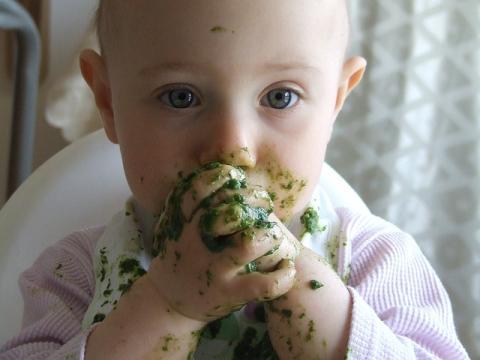
*These are my tips based on what worked for my family. It is not medical advice. Please consult your Pediatrician before starting your baby on a feeding program.
Often when we think of babies’ and toddlers’ eating habits we make a direct correlation with pickiness. It’s so ubiquitous that many American restaurants provide kids with their own menu featuring exclusively beige, white and brown foods that are largely devoid of real nutrition. However, when we look elsewhere in the world, we are able to see that pickiness is not an inborn trait in our children; rather it is taught and learned. In India for example, young children happily consume vegetarian diets flavored with complex spices and herbs. In France, babies and toddlers are familiarized with a plethora of vegetables and lean proteins. Why is it that in the U.S. we’ve come to believe young kids require “kid food”? In my opinion, I believe it is a combination of many factors: Food marketing, exposure to unhealthy foods too young and with regularity, and a lack of objective nutritional information that is available to most family homes. Once these food behaviors become “normal” within our society they too become pervasive and then, contagious. Hearing phrases like, “Danny doesn’t like vegetables,” out of parents’ mouths is not unusual and when said in front of the child, normalizes and reinforces the child’s “dislike” of vegetables. So, how do we avoid having a child with unhealthy food preferences? Here are some of my favorite tips for building happy, healthy eaters from infancy and beyond.
1) It Starts Before They Are Born: When your baby is in the womb, he or she is able to taste everything you are eating. The amniotic fluid picks up flavors from your food and so begins the earliest formation of taste preferences[1]. This is another important reason for pregnant mothers to make sure they are eating a healthy and varied diet. Not only will it support the development of a healthy baby, a healthy diet during the fetal stages helps build healthy food preferences in your child as well.
2) DIY: Making your own baby food ensures you are giving your baby the freshest food possible, free of pesticides, preservatives and added flavors. It also allows you to make just one meal per mealtime by blending up what you are eating (barring any potential allergens or unapproved baby ingredients). If you own a high-powered blender, you can simply use that for your baby food making needs along with a great set of small glass storage containers for storing leftovers. If you do not have a high-powered blender or you prefer something that takes up less counter space and is a bit quieter, look into baby food making appliances. I personally really like the Magic Baby Bullet System. It is compact and the starter kit comes with everything you’ll need to prep, store, and freeze your cherub’s meals.
3) Baby Led Weaning: As your infant grows and gains dexterity along with some chompers of his or her own, you may consider the “Baby Led Weaning” feeding method. Baby Led Weaning involves allowing your baby to feed his or herself by providing the baby with a selection of foods that are cut up and are soft enough for your baby to safely eat dependent on where they are in their dental development.[2] It is also common to give larger pieces of harder foods so that your teething baby may gnaw and taste rather than eat certain items. Proponents of Baby Led Weaning attribute many benefits to this method of feeding. One of these benefits is that your child will develop healthier eating satiety rituals as they are in control of how much they eat and learn to stop when they are full from the beginning. Another is that babies will develop greater dexterity as they are picking up different sized items and maneuvering them to eat.[3] If you wish to try Baby Led Weaning for yourself, make sure you follow these Do’s and Don’ts. Many parents opt for this method as the only method by which to feed their babies and skip purees altogether. Do what you feel most comfortable with and what works best for your family. For us, utilizing a combination of purees and Baby Led Weaning was the ticket.
4) Setting Healthy Thresholds: As adults with years of eating experience we know that there is a big difference in the sweetness of a piece of fruit versus the sweetness of a piece of candy. We also know that the saltiness of a cracker is very different than the saltiness of a reasonably seasoned piece of fish. By avoiding exposing your baby to extreme levels of saltiness or sweetness, you are helping shape healthy thresholds or palate expectations. Your child should crave both sweet and salty things but we want these cravings to be easily satisfied via a peach, or a savory, wholesome meal. By using natural, whole foods, you ensure that that which is found in nature defines your baby’s definitions of salty and sweet. By the same mode of thinking, flavors that are commonly disliked by children are those found in the greener family of vegetables. This is often because they are bitter. Do not be tempted to mask this bitterness by “sneaking” kale into the sweet potatoes. Let your child become accustomed to and even crave the verdant flavors of greens. Even if he or she doesn’t like them right away, keep trying and read number 5 below.
5) You Get What You Get: This is sort of where tough love, if you will, comes into play. Remember, your baby will eat if he or she is hungry. Also remember that when you begin solids (usually at 6 months of age) he or she is receiving the majority of nutrition from breast milk or formula. The rhyme, “Before 1, food is for fun.” can be helpful to remember. So, if you offer something and it is refused, do not feel obliged to replace it with something else. It is not essential that children under one year of age finish all of their food. Also, DO reintroduce that same food a few days later and repeat this process until your baby seems more comfortable and takes a few bites. By not replacing the refused item, you set the appropriate expectations for your future feeding relationship. Your child will learn that what they are given they are to eat should they be hungry. This may sound inflexible or harsh but remember it is a major factor in creating a non-picky, well-nourished human being. It also beats catering to a child who will only eat macaroni and cheese or chicken nuggets, as these are often habits not outgrown completely or in the short term.
6) Beautiful, Bold and Not Bland: Baby food should not be bland. That said, it ought not be spicy, either, as babies have delicate oral tissues. However, from 6 months onward, I exposed my son to garlic, complex (not spicy) spices, fresh herbs, and ethnic flavors. Not only do these provide additional nutrition through phytonutrients and antioxidants, they assist you in building a sophisticated palate. In order for your child to get excited about the right types of foods, they need to be interesting, varied and feature something new often. This way your baby views eating as a pleasurable experience and develops positive relationships with food.
7) Fatten Them up: Fat is your friend -- well the good kinds of fat, that is. Your baby’s brain requires a lot of the good types of fat and cholesterol in order to develop optimally. This means do not shy away from offering rich, nutritive foods. As you must avoid tree nuts in the early feeding months, nut fat is not typically a viable option. However, there are plenty of others. Even though your son or daughter is drinking a lot of breast milk or formula before they are one, it can be helpful to still offer them full fat dairy. Full fat yogurt especially is a wonderful food that offers probiotics, essential fats and cholesterols as well as calcium and vitamin D for those growing bones. I opt for plain, organic, grass-fed, whole fat yogurts. Full fat coconut milk, which can be blended into green smoothies or used to make yummy chia pudding (more good fats!) is a lovely tropical, creamy way of offering nutritive fats. Also, cooking plenty of low mercury fish in healthy fats like coconut oil, grass fed ghee or extra virgin olive oil offers a double-whammy of amazing omegas for your baby. And let us not forget avocado, which is a great first food and easy for baby to grasp and eat on his or her own.
Your baby is smart. He or she doesn’t need his or her food to be dumbed down or narrowed into a niche, largely unhealthy category. Respect your baby’s ability to enjoy foods that are sophisticated and this may include foods that you yourself may not even like. Remember, the objective is to have them eat food that nourishes and builds strong bodies and minds but also to create adventurous eaters who see food as an experience, not as a task to be begrudged.








